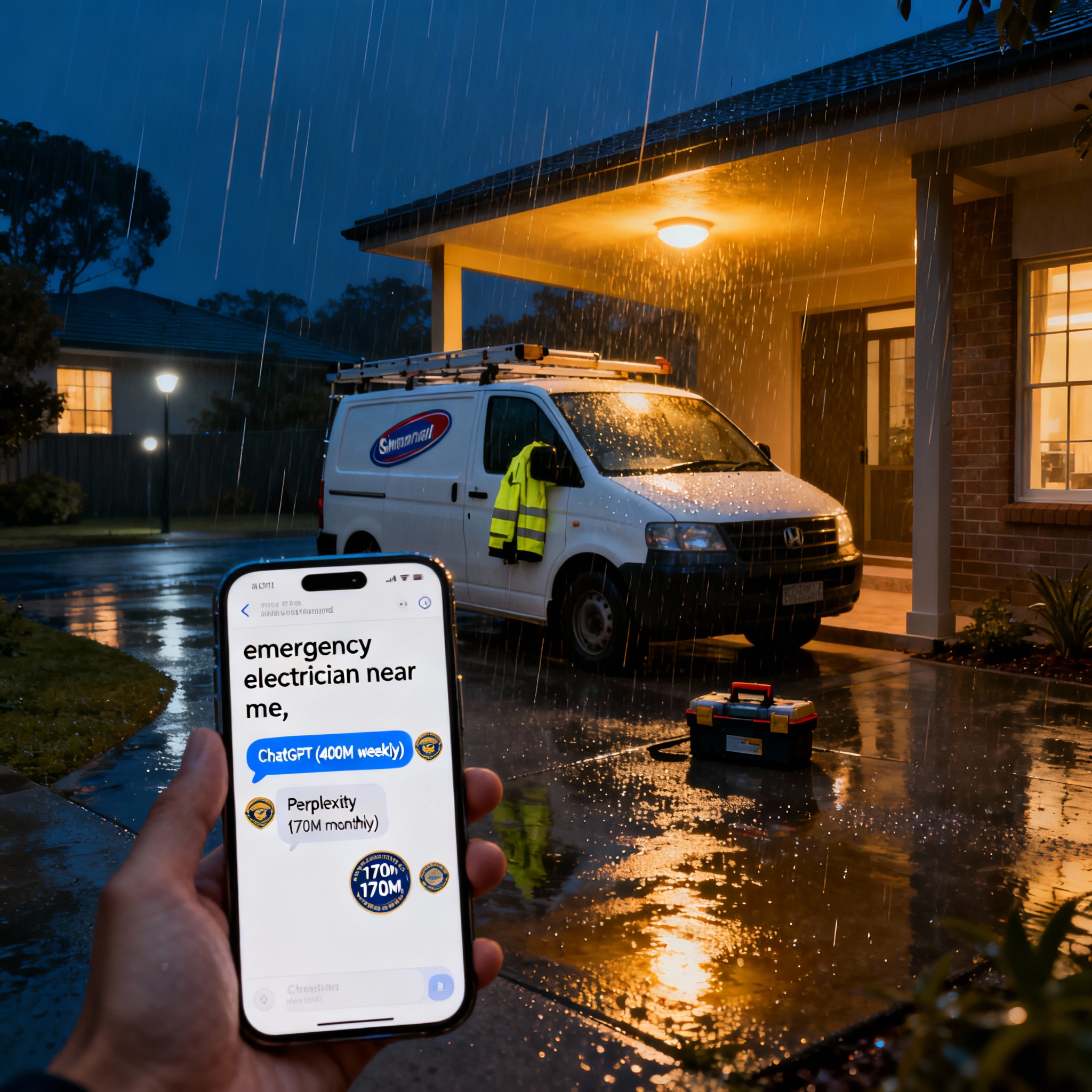
The 2026 Local SEO Audit Framework: Why Your Google Rankings Tell Only Half the Story
TL;DR: Your Google rankings tell you where you stand in traditional search, but they miss a growing visibility gap. ChatGPT has 400 million weekly users, and AI Overviews now appear in 13% of searches (up 102% in two months). This 11-point audit helps you assess both traditional and AI-driven visibility so you're not losing customers to competitors who show up where you don't.
What You'll Learn:
How to test if your business appears in ChatGPT and Perplexity for local queries
Why traditional rankings matter less when AI Overviews sit above your listing
The 11 checkpoints that reveal your true local visibility across all search formats
How to transform customer questions into AI-friendly content
Why service businesses face the highest AI Overview trigger rates (40.2% of queries)
You check your Google rankings weekly. You track website traffic in Analytics. You monitor your Google Business Profile views.
You assume this tells you everything about your local visibility.
It doesn't.
Right now, your potential customers are searching for your services in places you've never checked. ChatGPT has 400 million weekly users globally in 2025, doubling from 200 million in August 2024[1] Perplexity AI receives over 170 million monthly visits[2]. These platforms answer local service queries every single day.
When someone asks "best electrician in Perth" or "emergency plumber near me" in these AI tools, does your business appear?
Most service business owners have never tested this. They're optimising for a search environment that's becoming incomplete.
What Is the Visibility Gap Costing You?
AI Overviews now appear in 13.14% of all queries in March 2025, up from 6.49% in January 2025. That's a 102% increase in two months[3]. Some research shows AI Overviews appearing in up to 47% of Google searches[4].
Here's what this means for your business.
When you rank number three in Google, you feel good about your SEO. But if an AI Overview sits above your listing, capturing attention before users see traditional results, your ranking becomes less valuable. You're visible in one format whilst becoming invisible in another.
The data reveals something critical for service businesses. Between March 13 and 27, AI Overviews grew by 528% for entertainment queries, 387% for restaurant queries, and 381% for travel queries[3]. Service businesses consistently show the highest AI Overview trigger rates, with 40.2% of queries for businesses in the largest categories triggering AI Overviews as of April 2025[5].
If you run a plumbing business, accounting firm, or electrical service, you're in the sector most affected by this shift.
Bottom line: Traditional ranking metrics no longer capture your full visibility because they miss AI-driven search channels where your customers are already looking.
How to Audit Your Local SEO for 2026
This audit framework addresses both traditional organic search and emerging AI-driven formats. It's designed for time-poor service business owners who need a systematic approach without technical overwhelm.
1. Test Your AI Search Visibility First
Open ChatGPT and Perplexity. Type the exact queries your customers use: "[your service] in [your location]" or "best [your service] near me".
Does your business appear? Does your website get cited? Do competitors show up instead?
This takes 10 minutes and reveals whether you exist in the search channels your customers are using. Analysis of 391 SMB websites shows AI search engines are driving traffic to SMB sites. ChatGPT has consistently been the largest source of AI referral traffic, adding an average of 21% more traffic each month[6].
You're either capturing this traffic or losing it to competitors who've optimised for AI visibility.
Action step: Test your business name in ChatGPT and Perplexity today. Document which competitors appear when you don't.
2. Audit Your Traditional Google Rankings
Traditional rankings still matter. 97% of AI Overviews cite at least one source from the top 20 organic results, with Position 1 pages appearing in AI Overviews more than half the time[7].
Check your rankings for your core service keywords. But understand that ranking alone no longer guarantees visibility. You need to verify whether AI Overviews appear for your target keywords and whether you're featured in them.
What this means: Strong traditional SEO provides the foundation, but you need visibility in both traditional results and AI formats to capture all potential customers.
3. Verify Your Google Business Profile Completeness
Google's AI doesn't randomly pick businesses to highlight. It relies on clear, structured information. If your business data is inconsistent or disorganised, you risk being overlooked.
Check every field in your Google Business Profile:
Business name, address, phone number (NAP)
Business hours including special hours
Service areas and categories
Business description with specific services
Attributes that apply to your business
Photos updated within the last 90 days
Posts published regularly
Local SEO expert Will Scott emphasises that when building ontologies, consistency matters significantly. LLMs give wrong information when data is inconsistent, and disambiguation through context becomes critical[8].
Quick win: Complete every field in your Google Business Profile today. Upload fresh photos from the last 90 days.
4. Assess Your NAP Consistency Across All Platforms
Your business name, address, and phone number must match exactly across every platform where AI tools gather data.
Check these sources:
Your website footer and contact page
Google Business Profile
Facebook Business Page
Industry directories
Citation sites
Review platforms
Small variations create confusion for AI algorithms. "123 Main St" versus "123 Main Street" or "Pty Ltd" versus "Pty. Ltd." fragments your online presence.
Why this matters: AI systems need consistent data to confidently recommend your business. Inconsistencies reduce your chances of appearing in AI search results.
5. Evaluate Your Review Strategy and Management
AI Overviews often display customer reviews, making active review management essential for appearing in AI Overviews for "near me" searches[9].
AI goes beyond star ratings. It picks up on recurring themes in reviews. If customers frequently mention specific strengths, search algorithms associate those strengths with your business.
Audit your review profile:
Total number of reviews across all platforms
Average rating on each platform
Recency of reviews (reviews from the last 30 days)
Response rate to reviews
Common themes in positive reviews
Issues raised in negative reviews
Reviews are no longer social proof alone. They're structured data sources that AI uses to understand what your business does best.
Action step: Respond to all recent reviews this week. Ask satisfied customers to mention specific services they valued.
6. Analyse Your Question-Based Content
Keywords that trigger AI Overviews tend to be slightly longer in word count, more likely to include clarifications, comparisons, or definitions. Queries with eight words or more are 7x more likely to get an AI Overview in results[3][10].
You already know the questions customers ask. You hear them daily in phone calls and consultations.
Audit your website for question-based content:
Do you have dedicated pages answering common customer questions?
Are questions phrased exactly as customers ask them?
Do answers provide specific, detailed information?
Have you covered comparison queries ("X versus Y")?
Do you address cost-related questions transparently?
The strategic insight here is simple. Transform the questions you answer verbally every day into written content that AI references.
Quick win: Write three pages this week answering your three most common customer questions. Use the exact phrasing customers use when they call.
7. Check Your Website Technical Foundation
AI tools and traditional search engines both require proper website structure to understand and index your content.
Verify these technical elements:
Page load speed (under 3 seconds on mobile)
Mobile responsiveness and usability
Proper heading structure (H1, H2, H3)
Schema markup for local business
XML sitemap submitted to Google
HTTPS security certificate
Minimal JavaScript dependency for core content
About two-thirds of all Google searches happen on mobile devices, and now the majority of those mobile searches get an AI Overview[10]. For service businesses where customers search on the go for urgent needs, mobile optimisation combined with AI readiness becomes the defining factor in whether they find you.
What this means: Technical foundations affect both traditional and AI search visibility. Fix technical issues to improve performance across all search formats.
8. Assess Your Local Content Depth
AI Overviews only show on about 7% of all local queries. Local search is less affected for now, with AI Overviews appearing less frequently for local search queries compared to general informational searches[10][11].
This creates a window of opportunity.
Whilst competitors in informational spaces lose traffic to AI summaries, local service businesses who optimise correctly still capture traditional search traffic whilst simultaneously preparing for AI visibility.
Audit your location-specific content:
Do you have dedicated pages for each service area?
Does content mention specific suburbs, landmarks, or local references?
Have you created content about local events or community involvement?
Do you address location-specific service variations?
Opportunity: Local service businesses have more time to adapt than informational sites. Use this window to strengthen both traditional and AI visibility.
9. Evaluate Your Structured Data Implementation
Structured data helps AI understand your business information in a format it processes easily.
Check for these schema types:
LocalBusiness schema
Service schema for each service you offer
Review schema for testimonials
FAQ schema for question-based content
Opening hours specification
Geographic coordinates
You test your structured data using Google's Rich Results Test tool. Proper implementation makes your business information machine-readable, which directly impacts AI search results.
Why this matters: Structured data is the language AI systems use to understand your business. Without it, AI tools struggle to confidently recommend you.
10. Measure Your Current Traffic Sources
Understanding where your traffic comes from today establishes a baseline for measuring improvement.
Check your Google Analytics for:
Organic search traffic volume and trends
Traffic from AI referral sources (ChatGPT, Perplexity, others)
Google Business Profile clicks and calls
Direct traffic (often indicates brand searches)
Referral traffic from directories and citations
Since the Google March Core Update in 2025, the appearance of AI Overviews in search results has grown by 115%[11]. Semrush predicts that by 2028, AI search visitors will outnumber those from traditional search[11].
This is a three-year timeline, not a distant future scenario.
Action step: Set up tracking for AI referral sources in your Analytics today. Monitor these weekly alongside traditional metrics.
11. Document Your Competitive Position
Your visibility means nothing without context. You need to know where you stand relative to competitors.
For your top 3 to 5 competitors, check:
Their Google rankings for your shared keywords
Their appearance in AI search results
Their Google Business Profile completeness
Their review volume and ratings
Their website content depth
Their presence in local directories
This competitive audit reveals gaps you exploit and strengths you need to match.
What this reveals: Competitive analysis shows you exactly where to focus your efforts for maximum impact.
Why Early Action Creates Strategic Advantage
Service businesses implementing this audit framework in 2026 are being strategic, not cautious.
The data shows acceleration, not speculation. AI Overviews have grown 102% in two months. Service businesses face the highest AI Overview trigger rates. Mobile searches increasingly return AI-enhanced results.
Those waiting risk becoming invisible as customer search behaviour fundamentally shifts.
But here's the opportunity hidden in this disruption.
Most of your competitors haven't run this audit. They're still measuring success by Google rankings alone. They haven't tested their AI visibility. They haven't optimised their content for question-based queries. They haven't verified their structured data implementation.
The 80/20 principle applies here with particular force. 80% of your local SEO results will come from 20% of your efforts. This audit framework helps you identify that critical 20%.
Strategic insight: The businesses that adapt early capture market share whilst competitors remain invisible in emerging search channels.
How to Move from Audit to Action
Running this audit takes 2 to 3 hours if you're systematic about it. You don't need technical expertise. You don't need expensive tools. You need clarity about where you stand today.
Start with checkpoint one. Test your AI search visibility right now. Open ChatGPT or Perplexity and search for your services in your location.
What you learn in the next 10 minutes will tell you whether you're visible in the search channels that matter most in 2026.
The businesses that thrive over the next three years won't be the ones with the biggest marketing budgets. They'll be the ones who recognised this shift early and adapted their local SEO strategy to match how customers search.
Your audit starts now.
References
Exposure Ninja. (2024). Future of SEO Trends. Retrieved from https://exposureninja.com/blog/future-of-seo-trends/
DemandSage. (2024). Perplexity AI Statistics. Retrieved from https://www.demandsage.com/perplexity-ai-statistics/
Semrush. (2025). Semrush AI Overviews Study. Retrieved from https://www.semrush.com/blog/semrush-ai-overviews-study/
Single Grain. (2025). Google AI Overviews: The Ultimate Guide to Ranking in 2025. Retrieved from https://www.singlegrain.com/search-everywhere-optimization/google-ai-overviews-the-ultimate-guide-to-ranking-in-2025/
Local Falcon. (2025). Whitepaper: Studies the Impact of Google AI Overviews on Local Business Search Visibility. Retrieved from https://www.localfalcon.com/blog/whitepaper-studies-the-impact-of-google-ai-overviews-on-local-business-search-visibility
Search Engine Land. (2024). SMB Websites Rising Traffic from ChatGPT and AI Engines. Retrieved from https://searchengineland.com/smb-websites-rising-traffic-chatgpt-ai-engines-453201
SEO Clarity. (2024). AI Overviews Impact Research. Retrieved from https://www.seoclarity.net/research/ai-overviews-impact
Search Engine Land. (2025). AI Local Search Visibility and ROI. Retrieved from https://searchengineland.com/ai-local-search-visibility-roi-456272
Yext. (2025). AI Overviews Shaping Search for SMBs. Retrieved from https://www.yext.com/blog/2025/01/ai-overviews-shaping-search-smbs
Single Grain. (2025). Google AI Overviews: The Ultimate Guide to Ranking in 2025. Retrieved from https://www.singlegrain.com/search-everywhere-optimization/google-ai-overviews-the-ultimate-guide-to-ranking-in-2025/
WPBeginner. (2025). AI Reshaping SEO: Predictions to Watch. Retrieved from https://www.wpbeginner.com/research/ai-reshaping-seo-predictions-to-watch/
How do I test if my business appears in AI search tools?
Open ChatGPT or Perplexity and type queries your customers would use, like "[your service] in [your location]" or "best [your service] near me". Check if your business name, website, or services appear in the results. Test multiple variations of queries to get a complete picture.
Do traditional Google rankings still matter with AI search growing?
Yes. 97% of AI Overviews cite at least one source from the top 20 organic results[7]. Traditional SEO provides the foundation for AI visibility. Strong rankings increase your chances of appearing in AI-driven results, but rankings alone don't guarantee AI visibility.
What makes content AI-friendly versus traditional SEO-friendly?
AI-friendly content answers specific questions using the exact phrasing customers use. Focus on question-based content with clear, detailed answers. Queries with eight words or more are 7x more likely to trigger AI Overviews[3][10]. Transform the questions you answer verbally into written content.
How often should I run this local SEO audit?
Run a complete audit quarterly. Test your AI search visibility monthly because this area changes rapidly. Monitor your traditional rankings and traffic weekly. The search environment is shifting quickly, so regular checks help you adapt before losing visibility.
What's the biggest mistake service businesses make with local SEO in 2026?
Measuring success by Google rankings alone whilst ignoring AI search visibility. Most service business owners have never tested whether they appear in ChatGPT or Perplexity, yet their customers use these tools daily. This creates a visibility gap that competitors exploit.
How long does it take to improve AI search visibility?
Basic improvements like completing your Google Business Profile and ensuring NAP consistency show results within weeks. Building question-based content and structured data takes 2 to 3 months to impact AI visibility. The timeline depends on your current foundation and implementation speed.
Do I need technical skills to implement this audit framework?
No. Most checkpoints require systematic checking rather than technical expertise. Testing AI visibility takes 10 minutes. Verifying your Google Business Profile completeness is straightforward. For technical elements like structured data, you work with your web developer or use tools that simplify implementation.
Why do service businesses face higher AI Overview trigger rates?
Service-based businesses show the highest AI Overview trigger rates (40.2% of queries) because customers ask specific questions about services, costs, and local availability. These question-based queries trigger AI Overviews more frequently than simple navigational searches.
Key Takeaways
Traditional Google rankings tell only half your visibility story. ChatGPT has 400 million weekly users, and AI Overviews now appear in 13% of searches, up 102% in two months.
Test your AI search visibility first. Open ChatGPT or Perplexity and search for your services. This 10-minute test reveals whether you exist where customers are looking.
Service businesses face the highest AI Overview trigger rates at 40.2%. If you run a plumbing, accounting, or electrical business, you're in the most affected sector[5].
Question-based content is essential for AI visibility. Transform the questions you answer verbally every day into written content. Queries with eight words or more are 7x more likely to trigger AI Overviews[3][10].
NAP consistency across all platforms directly impacts AI recommendations. Small variations like "St" versus "Street" fragment your online presence and reduce AI confidence in recommending you.
Reviews are now structured data sources for AI. AI systems pick up recurring themes in reviews and associate those strengths with your business beyond simple star ratings.
The 80/20 principle applies with force here. 80% of your local SEO results come from 20% of your efforts. This audit framework identifies that critical 20% so you focus where it matters most.





